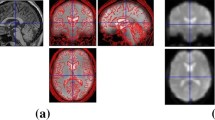Abstract
The competitive layer model (CLM) implemented by the Lotka–Volterra recurrent neural networks (LV RNNs) is prominently characterized by its capability of binding neurons with similar feature into the same layer by competing among neurons at different layers in a column. This paper proposes to use the CLM of the LV RNN for detecting brain activated regions from the fMRI data. The correlated voxels from brain fMRI data can be obtained, and the clusters from fMRI time series can be uncovered. Experiments on synthetic and real fMRI data demonstrate the effectiveness of binding activated voxels into the ‘active’ layers of the CLM. The activated voxels can be detected more accurately than some existing methods by the proposed method.












Similar content being viewed by others
Explore related subjects
Discover the latest articles, news and stories from top researchers in related subjects.References
Ogawa S, Lee TM, Kay AR, Tank DW (1990) Brain magnetic resonance imaging with contrast dependent on blood oxygenation. Proc Natl Acad Sci 87:9868–9872
Bihan DL (1995) Diffusion and perfusion magnetic resonance imaging: application to functional MRI. Raven, New York
Belliveau JW, Kennedy DN, McKinstry RC, Buchbinder BR, Weisskoff RM, Cohen MS, Vevea JM, Brady TJ, Rosen BR (1991) Functional mapping of the human visual cortex by magnetic resonance imaging. Science 254:716–719
Bandettini P, Jesmanowicz A, Wong E, Hyde J (1993) Processing strategies for time-course data sets in functional MRI of the human brain. Magn Reson Med 30(2):161–173
Friston KJ, Jezzard P, Turner R (1994) Analysis of functional MRI time-series. Hum Brain Mapp 2:69–78
Friston KJ (1996) Statistical parametric mapping and other analyses of functional imaging data. Brain mapping: the methods. Academic Press, San Diego, pp 363–396
Sychra JJ, Bandettini PA, Bhattacharya N, Lin Q (1994) Synthetic images by subspace transforms I. Principal components images and related filters. Med Phys 21(2):193–201
Backfrieder W, Baumgartner R, Samal M, Moser E, Bergmann H (1996) Quantification of I intensity variations in functional MR images using rotated principal components. Phys Med Biol 41:1425–1438
McKeown MJ, Makeig S, Brown GG, Jung TP, Kindermann SS, Bell AJ, Sejnowski TJ (1998) Analysis of fMRI data by blind separation into independent spatial components. Hum Brain Mapp 6:160–188
Zhang J, Cheng W, Wang Z, Zhang Z, Lu W, et al. (2012) Pattern classification of large-scale functional brain networks: identification of informative neuroimaging markers for epilepsy. PLoS ONE 7(5):e36733. doi:10.1371/journal.pone.0036733
Wang D, Shi L, Yeung DS, Tsang ECC, Heng PA (2007) Ellipsoidal support vector clustering for functional MRI analysis. Pattern Recogn 40:2685–2695
Chen H, Yuan H, Yao D, Chen L, Chen W (2006) An integrated neighborhood correlation and hierarchical clustering approach of functional MRI. IEEE Trans Biomed Eng 53:452–458
Goutte C, Toft P, Rostrup E, Nielsen FA, Hansen LK (1999) On clustering fMRI time series. NeuroImage 9:298–310
Chuang KH, Chiu MJ, Lin CC, Chen JH (1999) Model-free functional MRI analysis using Kohonen clustering neural network and fuzzy c-means. IEEE Trans Med Imaging 18(12):1117–1128
Baune A, Sommer FT, Erb M, Wildgruber D, Kardatzki B, Palm G, Grodd W (1999) Dynamical cluster analysis of cortical fMRI activation. NeuroImage 9:477–489
Chen S, Bouman CA, Lowe M (2004) Clustered components analysis for functional MRI. IEEE Trans Med Imaging 23(1):85–98
Lohmann G, Bohn S (2002) Using replicator dynamics for analyzing fMRI data of the human brain. IEEE Trans Med Imaging 21(5):485–492
Yi Z, Zhang L, Yu J, Tan KK (2009) Permitted and forbidden sets in discrete-time linear threshold recurrent neural networks. IEEE Trans Neural Netw 20:952–963
Yu J, Yi Z, Zhang L (2009) Representations of continuous attractors of recurrent neural networks. IEEE Trans Neural Netw 20:368–372
Zhang L, Yi Z, Zhang SL, Heng PA (2009) Activity invariant sets and exponentially stable attractors of linear threshold discrete-time recurrent neural networks. IEEE Trans Automatic Control 54(6):1341–1347
Zhang L, Yi Z, Yu J (2008) Multiperiodicity and attractivity of delayed recurrent neural networks with unsaturating piecewise linear transfer functions. IEEE Trans Neural Netw 19(1):158–167
Zhang L, Yi Z (2011) Selectable and unselectable sets of neurons in recurrent neural networks with saturated piecewise linear transfer function. IEEE Trans Neural Netw 22(7):1021–1031
Retter H (1990) A spatial approach for feature linking. Proc Int Neural Netw Conf 2:898–901
Wersing H, Steil JJ, Ritter H (2001) A competitive layer model for feature binding and sensory segmentation. Neural Comput 13(2):357–387
Weng S, Wersing H, Steil JJ, Ritter H (2006) Learning lateral interactions for feature binding and sensory segmentation from prototypic basis interactions. IEEE Trans Neural Netw 17(4):843–862
Voultsidou M, Dodel S, Herrmann JM (2005) Neural networks approach to clustering of activity in fMRI data. IEEE Trans Med Imaging 24:987–996
Yi Z (2010) Foundations of implementing the competitive layer model by Lotka–Volterra recurrent neural networks. IEEE Trans Neural Netw 21:494–507
Buxton R, Wong E, Frank L (1998) Dynamic of blood flow and oxygenation change during brain activation: the Balloon model. Magn Reson Med 39(6):855–864
Friston K, Mechelli A, Turner R, Price C (2000) Nonlinear responses in fMRI: the Balloon model, Volterra kernels, and other hemodynamics. Neuroimage 12(4):466–477
Ashburner J, Chen C, Flandin G, Henson R, Kiebel S, Kilner J, Litvak V, Moran R, Penny W, Stephan K, Hutton C, Glauche V, Mattout J, Phillips C (2009) SPM8 manual. The FIL Methods Group, Institute of Neurology UCL. http://www.fil.ion.ucl.ac.uk/spm/data/
Ardekani BA, Kanno I (1998) Statistical methods for detecting activated regions in functional MRI of the brain. Magn Reson Imaging 16(10):1217–1225
Acknowledgments
The authors wish to thank the reviewers for their valuable comments and helpful suggestions. This work was supported by the National Science Foundation of China under Grant 60931160441. And this work was also partly supported by the Scientific Research Fund of SiChuan Provincial Education Department (12ZA172).
Author information
Authors and Affiliations
Corresponding author
Rights and permissions
About this article
Cite this article
Zheng, B., Yi, Z. Using competitive layer model implemented by Lotka–Volterra recurrent neural networks for detecting brain activated regions from fMRI data. Neural Comput & Applic 22 (Suppl 1), 395–404 (2013). https://doi.org/10.1007/s00521-012-0972-8
Received:
Accepted:
Published:
Issue Date:
DOI: https://doi.org/10.1007/s00521-012-0972-8




